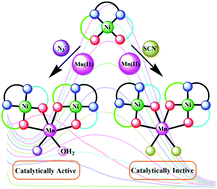Tri- and hexa-nuclear NiII–MnII complexes of a N2O2 donor unsymmetrical ligand: synthesis, structures, magnetic properties and catalytic oxidase activities†
Abstract
A new mononuclear Ni(II) complex, [NiL] (1) of an unsymmetrically dicondensed N2O2 donor ligand, H2L (where H2L = N-α-methylsalicylidene-N′-salicylidene-1,3-propanediamine), has been synthesized. Complex 1, on reaction with Mn(II) in the presence of different co-anions, yielded three heterometallic NiII–MnII complexes, [(NiL)2Mn(NCS)2]·CH3CN (2), [(NiL)2Mn(N3)(H2O)](ClO4)·H2O (3) and [{(NiL)2Mn(H2O)}2(μ1,3-N3)](ClO4)3 (4). Single crystal structural analyses show that complexes 2 and 3 contain similar bent trinuclear NiII2MnII structures, with the difference that in complex 2 two SCN− ions and in 3, one N3− and one H2O molecule are coordinated to the Mn(II) centre. Complex 4 possesses a hexanuclear structure, in which two trinuclear NiII2MnII units are connected via a single μ1,3-azido bridge. Variable temperature dc molar magnetic susceptibility measurements reveal that the two Mn(II) centres in complex 4 are antiferromagnetically coupled with an exchange coupling constant (J) of −3.73 cm−1. Among the three heterometallic complexes, only 3 and 4 show bio-mimetic catalytic oxidase activities. For catecholase like activity, the turnover numbers (Kcat) of complexes 3 and 4 are 984 and 2081 h−1, respectively, whereas for phenoxazinone synthase-like activity, the turnover numbers of complexes 3 and 4 are 6351 and 10 545 h−1, respectively. The high catalytic oxidase activities of complexes 3 and 4 in contrast to the inactivity of complex 2 are attributed to the coordination of a water molecule to the Mn(II) centre in the former structures, which facilitates the binding of the substrate with the catalyst. Mass spectral analyses suggest the probable formation of a complex–substrate intermediate in these catalytic reactions and cyclic voltammetry measurements show that Ni(II) is reducible to Ni(I).



 Please wait while we load your content...
Please wait while we load your content...